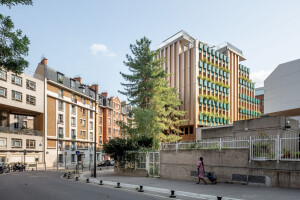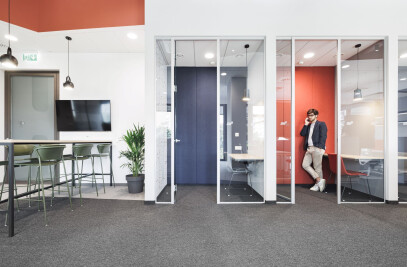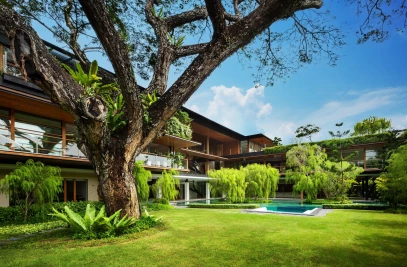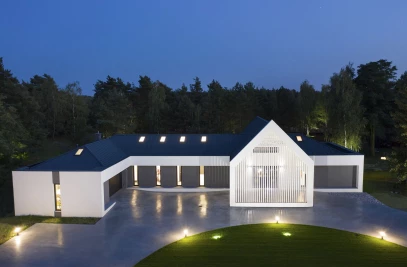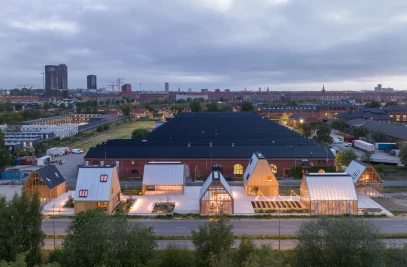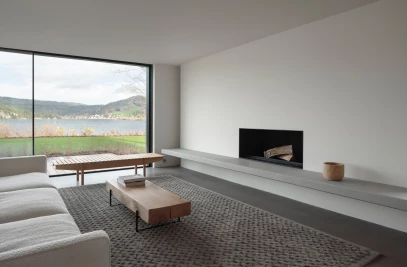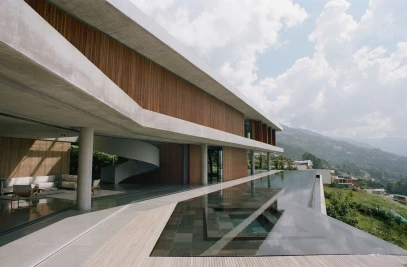The Edison Lite co-housing project by Manuelle Gautrand translates design principles from permaculture into built form. The project, located in the 13th arrondissement of south-east Paris, comprises a building with a total surface area of 2067m2 incorporating 21 residential units and two ground floor commercial spaces, as well as a number of shared spaces accessible to all residents for a variety of functions centred around inhabitant wellness and community building.

The project was inspired by the ‘Reinventer Paris’ initiative by the City of Paris, an urban renewal competition that sought applications for the redevelopment of 22 sites scattered across the city. Competition winners were allowed to rent or purchase their chosen site and thus collectively participate with other winners in a large scale urban experiment giving designers the power to rethink and reshape the way that Parisians live, work, and play.
Edison Lite proposed a new housing model based on three core principles; made to measure housing units offering agency for future residents to participate in the design process; the provision of an extra 20% of surface area conceived as shared space which would provide residents access to facilities and functions that they would not typically have access to individually; and to build an existing landscape prior to human habitation by pre-planting a living scaffolding based on planter boxes, thus welcoming and enfolding new residents into an already existing landscape for which they would subsequently assume responsibility.

All three principles were concepts adapted from permaculture, which seeks to consciously design and maintain productive agricultural systems to incorporate the diversity, stability and resilience of natural ecosystems, creating harmony between landscape and people in how they consume energy, food, shelter, and other non-material needs.
In terms of shelter, the apartments were sold at a fixed price of 7,990 € per square metre (inclusive of tax), a figure 30% lower than prevailing market rate. Online digital home design platform HABX handled the sales and marketing for the units, receiving almost 2,000 applications for the 13 open-market units. Buyers were assessed and selected across a range of criteria designed to ensure a diverse but also compatible community of inhabitants. This philosophy also extended to the bids for the two commercial spaces which were awarded to a creche and a physiotherapy practice.

The urban fabric of the area surrounding the project is extremely diverse, both in terms of design and style. The site for the building was a tiny 415m 2 plot abutting the prestigious Maurice Ravel school of music. Surrounding buildings are imposing in height, and this intimidation combined with the restriction of the perimeter led the architects to adopt a creative design process that would allow them to ‘out manoeuvre’ constraints.
Growing urban density is a constant challenge for cities across the globe, and needs to be balanced with a respectful and harmonious integration into the wider neighbourhood. To make the case for densification within a permaculture framework the new project sough to not only renew, but re-attribute its functions, adding value and literally embellishing the site.
Beyond customizable units, 20% of the site was programmed as shared communal space. These were designed as a guided architectonic experience, residents traversing a route through communal and meeting spaces starting in the basement and ascending to the rooftop. These group spaces also occupy the most prestigious sites within the building – those with the best views and access to natural light that would typically be reserved for large and expensive upper-level apartments. Part of the value add of the project was this inversion from the norm, providing equality of access to all residents and strengthening a sense of community; inviting inhabitants to collaborate on a shared sense of home as co-created through their individual iterations. Communal functions range from a workshop and bicycle storage accessed from a large entrance hall on the lower levels to a huge area on the sixth floor incorporating a south-facing sun deck and a west-facing open-air barbeque and kitchen area.
The roof, level seven, features a 150 m2 urban farm, a community vegetable plot with 360-degree views. This plot has been created for residents to grow their own food and encourage collective participation in a shared outcome, creating a culture of edible permaculture. Each resident was given tutorial upon arrival on how to grow food and the plot is divided equally amongst all residents so that each family has their own mini-garden. Such communal spaces also allow the best of what we conceive of as ‘home,’ to be articulated within the frame of an apartment complex. The building provides the convenience of patio, workshop, storage and garden areas typical of a suburban house, but is located in the heart of central Paris. Group spaces also serve to attract inhabitants with a shared aspiration to live in harmony and continuity with their neighbours and with nature.

In 2001 the City of Paris adopted a set of objectives aimed toward becoming a model of urban agricultural sustainability. In 2016 it extended this in the ‘100 hectares’ charter, with a goal of reaching 100 hectares of planted walls and roofs. Including the roof allotment, the Edison Lite building incorporates 10m 2 of soil per apartment, with soil making up 40% of the original footprint coverage.
Ecosystem sustainability also informed the choice of materials for the project, with the guiding philosophy being ‘the right material in the right place’. Concrete, timber, and metal are incorporated to best use according to which function they are part of embodying.
The green ethos and abundant planting in communal spaces extends into private spaces, with a green façade that is both largely glazed and largely planted. A total of 290 planters punctuate the façade windows, an average of 14 planters per unit, creating the effect of both a ‘lung’ for urban views as well as air.

Timber is the dominant façade material, acting as a kind of bark around the concrete façade posts. The building’s inner concrete trunk/core comprises the stairwell, lift cage and landings. This structure frees the floor plates from intermediary structural elements, facilitating customization of individual unit plans. Timber-framed spandrel panels are spaced at 1.2 metre intervals between the façade posts, alternating in concrete to distribute the loads. Façade posts are used for distribution of planter watering and drainage systems, and are enclosed in thermally modified timber. External windows including French doors opening onto terraces are stained in solid pine.
The façade planters hold 310 passionflower plants as part of the collective garden portfolio, which also includes 4,320 bulbs and an additional 1,418 Luzula flowering rushes in the residents’ private planters. In total, over 6,000 plants had already created a living biosphere that enveloped guests as they moved in, enfolding them into the building itself and incorporating them into a living, breathing ecosystem. Each planter has a passionflower at each end, which are part of the collective but cared for and tended by families and dwellers within each apartment. In the core of each planter, less established bulbs and flowers emerge, a starter kit for gardening that gently cultivates green thumbs. Each planter is also fitted with an automatic watering system ensuring year-round moisture and optimal growth conditions.

By enveloping the natural world around construction and incorporating soil and vegetation as organic building materials, Edison Lite interweaves and interlinks public and private spaces, creating a happy, healthy, and self-sustaining community. By designing individual apartments to form components of a larger whole and integrating residents, facades, and the roof into one ensemble, the project articulates a narrative for a new model of housing and how we imagine it. Residents are enveloped in and inspired by nature, encouraged to literally cultivate food for human consumption but also to cultivate a relationship with nature itself, nurturing it as it nurtures them and collectively building a human/natural/built hybrid ecosystem for the future.












